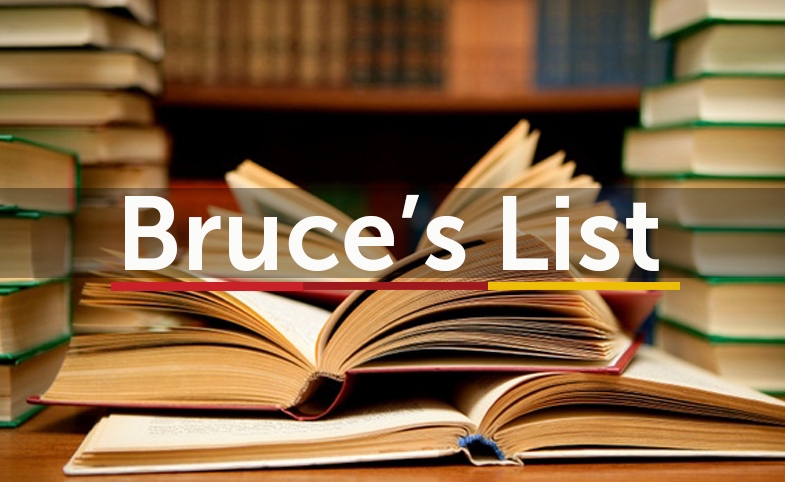The October 2016 edition of Bruce Gregory's public diplomacy reading list is now available. Known affectionately at CPD as "Bruce's List," this list is a compilation of books, journal articles, papers and blogs on a wide...
KEEP READING
Latest Must-Reads in Public Diplomacy: April 2017
The April edition of Bruce Gregory's public diplomacy reading list is now available. Known affectionately at CPD as "Bruce's List," this list is a compilation of books, journal articles, papers and blogs on a wide variety of PD topics, and features a number of CPD scholars. Highlights from this list include:
Geoffrey Cowan, Why the Voice of America Remains a Vital Force in the World, CPD Perspectives, USC Center for Public Diplomacy, March 2017. Cowan (former dean of USC’s Annenberg School of Communication and Journalism and director of the Voice of America) reflects on his family’s association with VOA, its historical and continuing importance, his role in creating USC’s Center for Public Diplomacy and MA degree in public diplomacy, and key questions facing US international broadcasting and public diplomacy in the Trump administration. His paper is adapted from a speech delivered at the World Affairs Council of the Desert in Indian Wells, CA, on December 15, 2016.
Mai’a K. Davis Cross and Teresa La Porte, “The European Union and Image Resilience During Times of Crisis: The Role of Public Diplomacy,” The Hague Journal of Diplomacy, 12 (2016), 1-26. Davis Cross (Northeastern University) and La Porte (University of Navarra) make two central claims. First, actors who experience setbacks often face consequences beyond those generated by root sources of their problems due to negative media effects, particularly those multiplied by social media. These effects on an actor’s external image, which may be long lasting, require image resilience. Second, “the ability to cultivate image resilience rests significantly on the power of public diplomacy.” A strong image over time enables greater resilience after initial organizational responses to the shocks and stress of a crisis. The authors examine the meaning of resilience in organization theory and in overcoming objective realities to ensure survival. They contrast and link these ideas with public diplomacy theory and the role of image resilience in “correcting subjective perceptions to restore reputation.” Three “conditions (protective tools)” contribute to an actor’s image resilience: policies, cultures, and identity that are attractive prior to a crisis; adaptive capacity; and “a strong sense of pro-social identity.” Using in-depth interviews, practitioners’ public statements, and scholarly literature, they explore these ideas in a case study of the EU’s public diplomacy in the United States intended to influence American perceptions of Europe’s eurozone crisis.
“University Deans Discuss ‘Trends in International Relations Curricula: Implications for Public Diplomacy,” First Monday Forum, University of Southern California/Public Diplomacy Council, April 3, 2017. In a panel discussion moderated by Sherry Mueller (American University) Deans James Goldgeier (American University, School of International Service), Joel Hellman (Georgetown University, School of Foreign Service,) Reuben Brigety II (George Washington University, Elliott School of International Affairs), and Adam Clayton Powell III representing Ernest Wilson (USC, Annenberg School of Communication) discuss issues relating to research, curricula, teachers, students practitioner oriented courses, future directions in the study of diplomacy and public diplomacy. The approximately one-hour program, covered by C-SPAN and not yet aired, is scheduled to appear on the website at the link. Check for updates also on the Public Diplomacy Council’s website.
Alexey Fominykh, “Russia’s Public Diplomacy in Central Asia and the Caucasus: The Role of the Universities,” The Hague Journal of Diplomacy, Vol. 12, No. 1, 2017, 56-85. Fominykh (Volga State University of Technology) argues that, while Russia’s public diplomacy directed at Ukraine and the Baltic states relies mostly on “manipulative methods,” its public diplomacy in Central Asia and the Caucasus uses a range of “softer” tools: educational exchanges, government scholarships, language instruction, and student recruitment. Fominykh’s research is based on international statistics on student flows collected by the Russian Federation and UNESCO’s country reports. His article includes views on soft power, distinctions between public diplomacy and international education, challenges of defining public diplomacy, and varieties of meaning in interpretations of public diplomacy by Russia’s practitioners and IR scholars.
Efe Sevin, Public Diplomacy and the Implementation of Foreign Policy in the US, Sweden and Turkey, (Palgrave Macmillan Series in Global Public Diplomacy, 2017). Sevin (University of Fribourg, Switzerland) combines critical insights into public diplomacy scholarship with a systematic comparison of selected projects linking public diplomacy and foreign policy in three countries. His book is a thoughtful inquiry into an ambitious research question: “Public diplomacy works, but how?” Sevin’s analytical framework, grounded in IR, diplomacy, and communication studies literature, consists of six pathways of connection and explanation: attraction, benefit of the doubt, socialization, direct influence, agenda setting, and framing. Empirical evidence in the cases is drawn from views of public diplomacy practitioners on how their projects helped to achieve foreign policy goals. He uses his theoretical pathways to analyze their views. The case projects are the “Education, Culture, Sports, and Media Working Group” of the US-Russia Bilateral Presidential Commission (2009), Sweden’s “Facing the Climate” project, and Turkey’s support for the international organization “Turksoy.Turksoy.” An impressive convergence of study and practice by an informed scholar.
The complete list is available here.
Tags
Visit CPD's Online Library
Explore CPD's vast online database featuring the latest books, articles, speeches and information on international organizations dedicated to public diplomacy.
Popular Blogs
-
November 3
-
November 5
-
November 13
-
November 25
-
December 17











